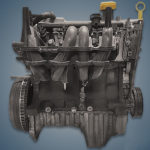The 1.2-liter 8-valve Renault D7F engine was produced by the concern from 1996 to 2014 and was installed on the company’s most compact models such as Twingo, Clio or Kangoo. In the Brazilian market, a 1.0-liter modification of this engine with the D7D index was offered.
The D-series also includes: D4F and D4Ft.
In 1996, Renault engineers introduced a compact engine designed for the Twingo model. Despite its small size, this engine had an in-line cast-iron 4-cylinder block, an 8-valve cylinder head without hydraulic lifters, a single ignition coil and a timing belt drive. Fuel injection here is distributed, which distinguishes it from older engines with single injection.
The first power units with indices 700 and 701 developed 58 hp and 93 Nm of torque, and after the update in 2001, the engines 702, 703 and 704 slightly increased power to 60 hp. On the first generation Clio model, there was a 730 modification derated to 54 hp, on the Clio 2 they installed a particularly economical gas version with a torque reduced to 88 Nm.
The engine was installed on:
- Renault Clio 1 (X57) in 1996 – 1998; Clio 2 (X65) in 1998 – 2006; Clio 2 Campus in 2006 – 2012;
- Renault Kangoo 1 (KC) in 1997 – 2001;
- Renault Twingo 1 (C06) in 1996 – 2007; Twingo 2 (C44) in 2007 – 2014.
Specifications
| Production years | 1996-2014 |
| Displacement, cc | 1149 |
| Fuel system | injector |
| Power output, hp | 58 – 60 54 (deforced ver.) |
| Torque output, Nm | 88 – 93 93 (deforced ver.) |
| Cylinder block | cast iron R4 |
| Block head | aluminum 8v |
| Cylinder bore, mm | 69 |
| Piston stroke, mm | 76.8 |
| Compression ratio | 9.5 |
| Hydraulic lifters | no |
| Timing drive | belt |
| Turbocharging | no |
| Recommended engine oil | 5W-30, 5W-40 |
| Engine oil capacity, liter | 4.8 |
| Fuel type | petrol |
| Euro standards | EURO 2/3/4 |
| Fuel consumption, L/100 km (for Renault Twingo 2000) — city — highway — combined |
7.6 4.8 5.8 |
| Engine lifespan, km | ~300 000 |
| Weight, kg | 82 |
Disadvantages of the Renault D7F engine
- A generally reliable unit most often worries its owners with electrical failures: here the air flow sensor, temperature, throttle position sensor fails.
- The manuals indicate the procedure for replacing the belt every 120,000 km, but if it bursts earlier, the valves in the engine will bend. Therefore, it is advisable to check its condition regularly.
- Loud noises under the hood are usually made by unadjusted valves, and to get to them you need to remove the valve cover, intake manifold and change their gaskets.
- Attachments do not have the highest resource in this power unit, lubricant leaks and overheating often occur due to failure of the cooling system fan.






